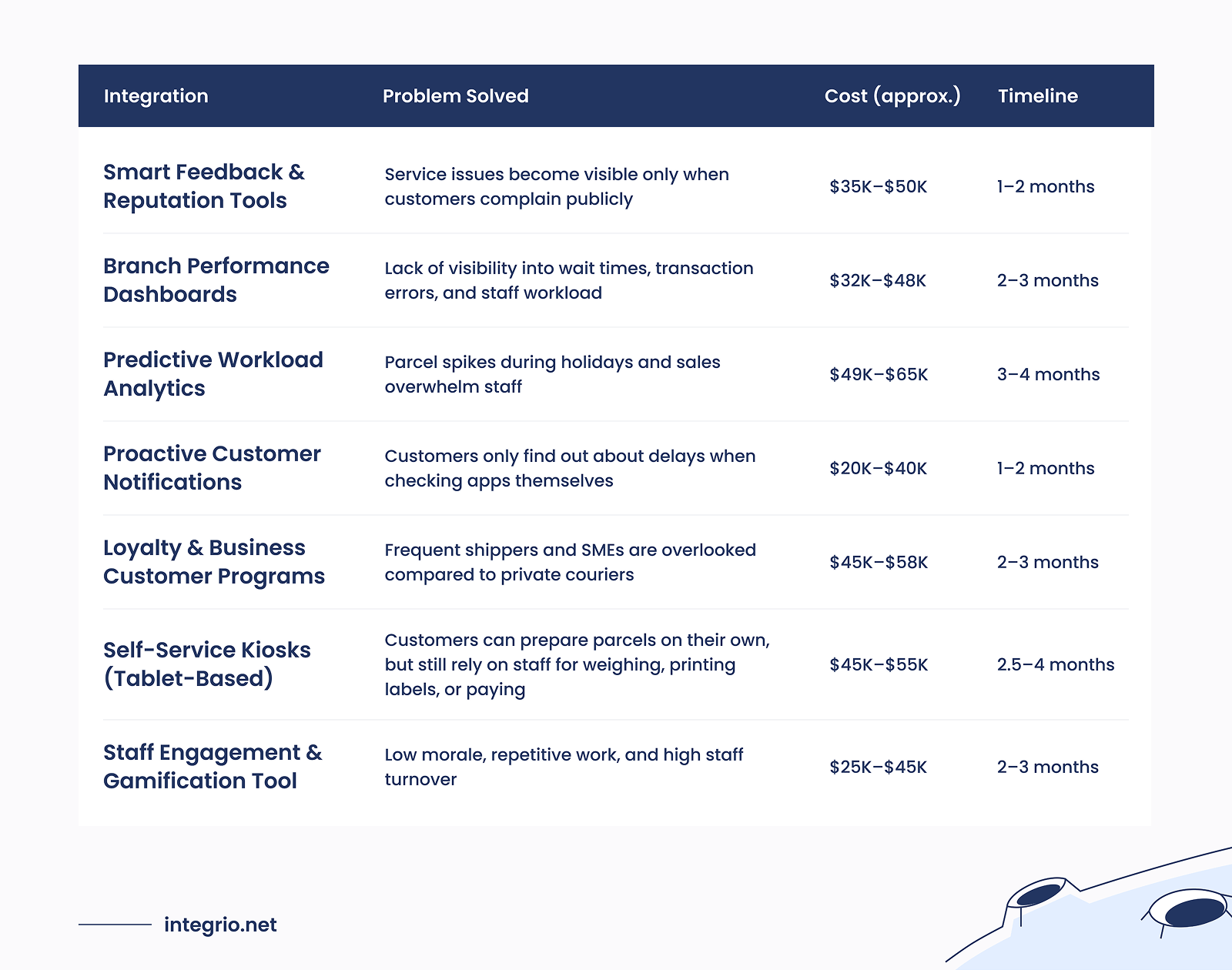Post Office Software Enhancement Options: 6 Custom Integrations to Improve Operations and Reduce Staff Turnover

Most post offices already have software installed for handling their core operations. And while it’s perfect for sorting, tracking, dispatching, and other day-to-day tasks, as customer expectations and workloads increase, it may no longer cover every need.
The good news? Modernizing it doesn’t mean starting from scratch and replacing everything. With the right custom post office software integrations, you can add the features that matter most for your business today. In this article, we discuss the top six such solutions.
6 Custom Integration Options Post Offices Can Add to Their Current Systems
Without a doubt, your core post office software does a lot of work. But when it comes to customer experience, process efficiency, or staff morale, there is room for improvement. Here are six integration options that can help:
Smart Feedback & Reputation Tools
Nobody likes finding out about service problems only after a negative review goes public. Unfortunately, that’s often how post offices realize something has gone wrong. A smart feedback tool lets you prevent this and build a positive public image. Here’s how:
- After a transaction, the tool encourages customers to rate their experience.
- If feedback is positive, the tool automatically publishes it on public review sites.
- If feedback is negative, the tool instantly sends it to managers so they can investigate and solve the issue before discontent grows and the review spreads.
With such an integration solution for post offices, you get a triple benefit. Your customers feel heard, managers act promptly, and your brand receives a steady stream of positive reviews.
Cost and timeline: ~$35K–$50K, 1–2 months.
Branch Performance Dashboards
To manage a branch effectively, you need to see what’s actually happening there. Dashboard tools for post offices let you do just that by offering such features as:
- Tracking average wait times, so you can see when customers are getting impatient.
- Monitoring transaction accuracy helps you identify the causes of errors.
- Reviewing staff workload distribution, showing who’s overwhelmed and who has the capacity to help.
Implementing such post office software enhancements means improving overall branch performance, as you can easily identify where the bottlenecks are.
Cost and timeline: ~$32K–$48K, 2–3 months.
Predictive Workload Analytics
You’ve definitely noticed that parcel volumes spike around holidays and online shopping events. Without proper preparation, these surges can overwhelm your staff, leading to delays and frustrated customers. Predictive analytics that uses AI and ML technologies helps you plan by:
- Using historical delivery data to identify recurring trends.
- Factoring in seasonality and local events to predict spikes.
- Using trends from partnership eCommerce platforms and past parcel data to forecast upcoming shipment volumes.
Including such predictive analytics AI integrations as part of your post office software brings several advantages. Your managers can schedule more staff during peak periods and scale back when volumes are lower. Plus, they can add extra routes before delays build up.
Cost and timeline: ~$49K–$65K, 3–4 months.
Loyalty & Business Customer Programs
Small eCommerce sellers and frequent shippers often get overlooked in traditional postal office systems. Yet, these customers can become some of the most loyal and profitable if given the right support. Custom integrations of loyalty or business programs make it easy to reward repeat use and simplify the process for bulk shippers. Here are the particular perks you can offer:
- Loyalty rewards, including bulk shipping discounts and options for faster processing.
- Business dashboards that centralize shipping history, invoices, and bulk order management.
Why consider these postal software solutions? They help you show small businesses that you care and, consequently, build strong, lasting relationships with them.
Cost and timeline: ~$45K–$58K, 2–3 months.
Self-Service Kiosks (Tablet-Based Software)
Customers rarely stand in long lines if there’s some kind of self-service possibility. In post offices, this can be self-service kiosks that let people prepare and process shipments themselves. Here’s how that works:
- Customers enter shipment details on a tablet interface.
- Tablets connect to scales, printers, and POS systems for labels and payments.
- Customers complete most routine steps independently, while your staff provides more complex services that require personal attention.
These postal service technology solutions offer three benefits at once: reduced waiting times, less staff workload, and higher customer satisfaction.
Cost and timeline: ~$45K–$55K, 2.5–4 months.
Staff Engagement & Gamification Tool
Post office work is often demanding, repetitive, and stressful. And when that constant pressure on your staff accumulates, it can result in low morale and high turnover. The solution is a gamified staff engagement tool, which may include:
- Leaderboards connected to POS for tracking data to highlight top performers.
- Points and rewards that employees can exchange for bonuses, such as team pizza, cash prizes, or family-friendly coupons.
- Interactive training quizzes for making skill-building a part of the everyday employee routine.
These staff turnover reduction tools are great since they recognize employees for their real efforts and strengthen overall team spirit.
Cost and timeline: ~$25K–$45K, 2–3 months.
Conclusion
At the end of the day, you don’t need a complete post office software overhaul to modernize your operations. What you need are the right tools that extend what you already have. We’ve described some of those in our article, including customer feedback solutions, branch performance dashboards, self-service kiosks, and more.
If you’re interested in integrating legacy corporate systems with modern platforms or exploring which post office software enhancements make the most sense for you, contact Integrio Systems. We’ll consult on how to make your processes smoother.

FAQ
We can do both. If you need a new postal management system, we can design one from the ground up. Yet, in most cases, extending your existing software with integrations is more practical and cost-effective. It’s a great way to get the new features fast without replacing your entire system.
Not always. Most of the post platforms integrations we described in our article can work on your existing computers and any other devices in use. However, to enable self-service kiosks, you’ll need touchscreen tablets connected to printers and scales.
Yes. Security is an indispensable part of the development process of our integration developers. In particular, we implement data encryption, access controls, and compliance with local regulations right from the outset.
We typically start with a small pilot project, such as an integration at one branch, to test it before going all in. Once we confirm that everything works correctly, we scale the same setup across other branches. With this approach, we ensure minimal downtime and increased operations efficiency in post offices.
A postal management system is usually an off-the-shelf product with fixed features for mail tracking, billing, and customer service. It works the same way for every organization. Custom software for post offices, on the other hand, is built around your exact workflows — for example, integrating with your local eCommerce partners, automating staff scheduling, or adding loyalty programs for frequent shippers. Custom solutions adapt to your needs instead of forcing you to adapt to the software.
Contact us

